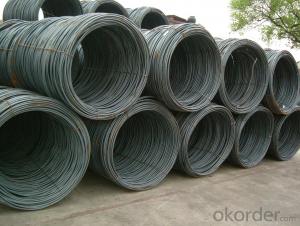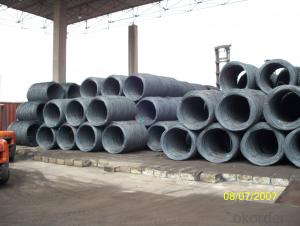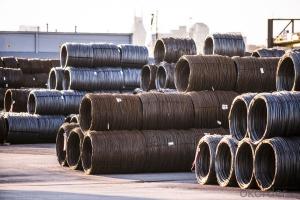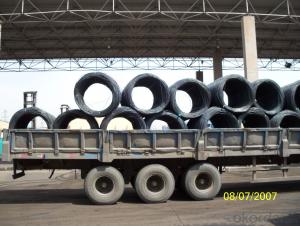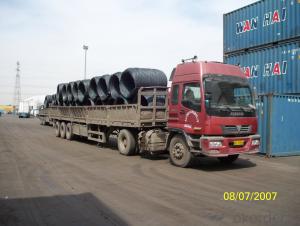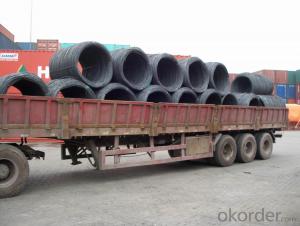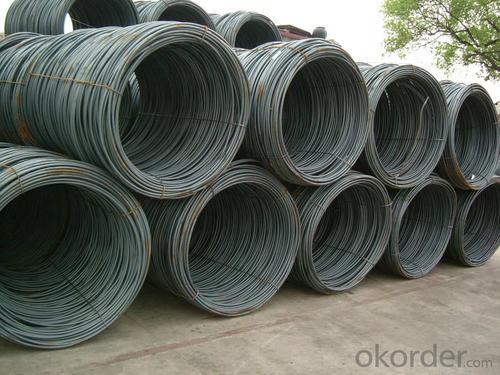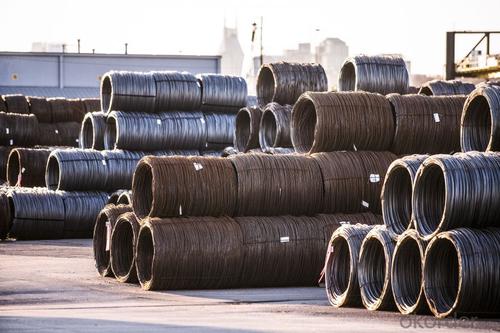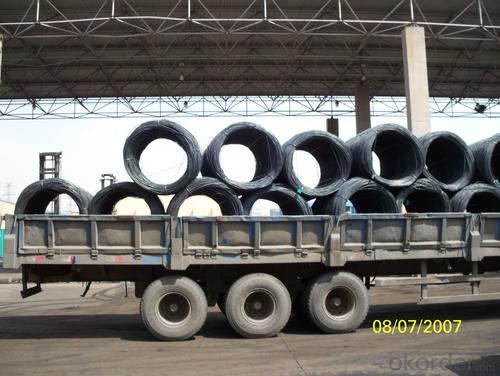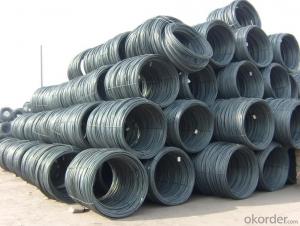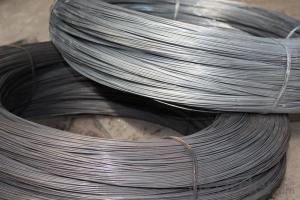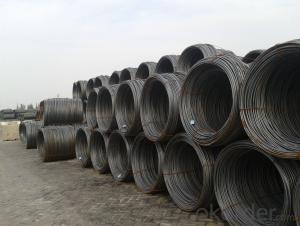SAE1006Cr Carbon Steel Wire Rod 7mm for Welding
- Loading Port:
- Shanghai
- Payment Terms:
- TT OR LC
- Min Order Qty:
- 100 m.t
- Supply Capability:
- 30000 m.t/month
OKorder Service Pledge
OKorder Financial Service
You Might Also Like
Specification
Description of SAE1006Cr Carbon Steel Wire Rod 7mm for Welding:
OKorder is offering Color Coated Steel Coil Prepainted Steel Coil at great prices with worldwide shipping. Our supplier is a world-class manufacturer of steel, with our products utilized the world over. OKorder annually supplies products to European, North American and Asian markets. We provide quotations within 24 hours of receiving an inquiry and guarantee competitive prices.
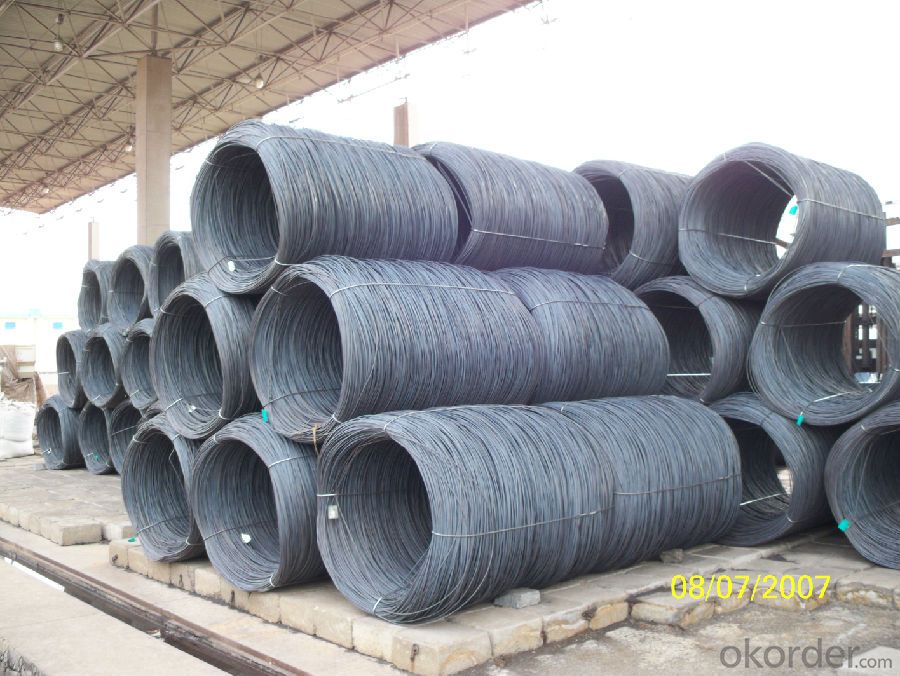
Applications of SAE1006Cr Carbon Steel Wire Rod 7mm for Welding:
Color Coated Steel Coil Prepainted Steel Coil are ideal for structural applications and are widely used in the construction of buildings and bridges, and the manufacturing, petrochemical, and transportation industries.
Main Product Features of SAE1006Cr Carbon Steel Wire Rod 7mm for Welding:
· Premium quality
· Prompt delivery & seaworthy packing (30 days after receiving deposit)
· Corrosion resistance
· Can be recycled and reused
· Mill test certification
· Professional Service
· Competitive pricing
Specifications of SAE1006Cr Carbon Steel Wire Rod 7mm for Welding:
PPGI:
1, Introduction: Color coated steel coils(sheets), i. E. PPGI, also called prepainted steel coils(sheets), are made of galvanized steel coils(sheets) with polymer coatings as surface. It's a new enclosure material and building board with characteristics of light-weighted, heat preserved&insulated, easily installed with bright colors.
2, Production Process: Pretreatment(Degreasing)_Drying_Chromating_Paint Basic Oil_Cooling_Drying_Color Coating_Cooling_Film-covering_Rolling Up
3, Characteristics:
Good at corrosion resistence. Besides zinc coating of the basic plate of galvanized steel sheet, the color coating as the surface has double lifetime to ensure better anticorrosion effect.
With excellent cold bending molded manufacturablity, PPGI products can be processed or directly used as final product. As being light-weighted and conveniently transported, they're widly used to replace wood to save energy.
4.There're thousands of colors can be chosen as per different application. Any color plays well in decoration.
No pollution with high recycling rate, PPGI coils and sheets are strongly recommended as enviroment-friendly products by the government.
5, eye bands and 4 circumferential bands in steel, galvanized metal fluted rings on inner and outer edges, galvanized.
| commodity | SAE1006Cr Carbon Steel Wire Rod 7mm for Welding |
| Techinical Standard: | JIS G3302-1998, EN10142/10137, ASTM A755 |
| grade | Q195,Q215,Q235,SAE1006,SAE1008 SAE1006Cr |
| Types: | Mesh welding |
| Base metal | galvanized, galvalume, cold rolled steel |
| Thickness | 0.14-1.0mm(0.16-0.8mm is the most advantage thickness) |
| Width | 610/724/820/914/1000/1200/1219/1220/1250mm |
| Type of coating: | PE, SMP, PVDF |
| Zinc coating | Z60-150g/m2 or AZ40-100g/m2 |
| Top painting: | 5 mic. Primer + 15 mc. R. M. P. |
| Back painting: | 5-7 mic. EP |
| Color: | According to RAL standard |
| ID coil | 508mm610mm |
| Coil weight: | 2--3MT |
| Package: | Properly packed for ocean freight exportation in 20'containers |
| Application: | Industrial panels, roofing and siding for painting/automobile |
| Price terms | FOB, CFR, CIF |
| Payment terms | 20%TT in advance+80% TT or irrevocable 80%L/C at sight |
| delivery time | 25 days after recepit of 20% TT |
| Remarks | Insurance is all risks |
| MTC 3.1 will be handed on with shipping documents | |
| We accept SGS certificatation test |
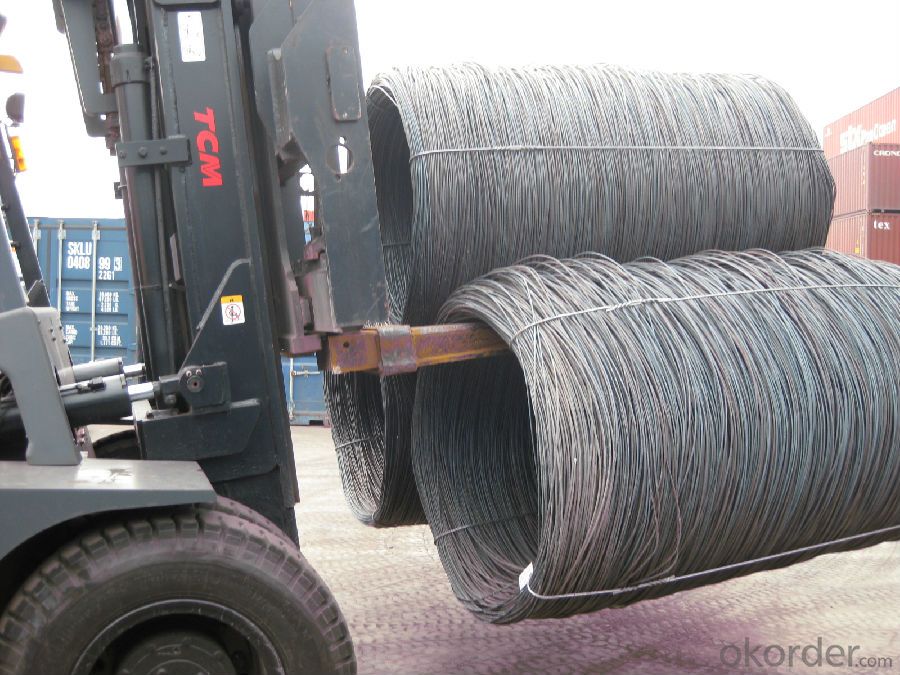
FAQ of SAE1006Cr Carbon Steel Wire Rod 7mm for Welding:
Q1: Why buy Materials & Equipment from OKorder.com?
A1: All products offered byOKorder.com are carefully selected from China's most reliable manufacturing enterprises. Through its ISO certifications, OKorder.com adheres to the highest standards and a commitment to supply chain safety and customer satisfaction.
Q2: How do we guarantee the quality of our products?
A2: We have established an advanced quality management system which conducts strict quality tests at every step, from raw materials to the final product. At the same time, we provide extensive follow-up service assurances as required.
Q3: How soon can we receive the product after purchase?
A3: Within three days of placing an order, we will begin production. The specific shipping date is dependent upon international and government factors, but is typically 7 to 10 workdays.
Q4: What makes stainless steel stainless?
A4: Stainless steel must contain at least 10.5 % chromium. It is this element that reacts with the oxygen in the air to form a complex chrome-oxide surface layer that is invisible but strong enough to prevent further oxygen from "staining" (rusting) the surface. Higher levels of chromium and the addition of other alloying elements such as nickel and molybdenum enhance this surface layer and improve the corrosion resistance of the stainless material.
Q5: Can stainless steel rust?
A5: Stainless does not "rust" as you think of regular steel rusting with a red oxide on the surface that flakes off. If you see red rust it is probably due to some iron particles that have contaminated the surface of the stainless steel and it is these iron particles that are rusting. Look at the source of the rusting and see if you can remove it from the surface.
- Q: How is steel wire rod used in the manufacturing of wire for automotive seat frames?
- Steel wire rod is an essential material used in the manufacturing process of wire for automotive seat frames. The wire rod is initially produced through a series of steelmaking processes, including melting, refining, and casting. Once the steel wire rod is formed, it undergoes further processing, such as hot rolling or cold drawing, to achieve the desired shape and size for the wire. In the production of wire for automotive seat frames, the steel wire rod is typically fed into a wire drawing machine. This machine pulls the wire rod through a series of dies, which progressively reduce the diameter of the wire while elongating it. This process helps to improve the wire's strength, flexibility, and surface finish. The resulting wire is then used to construct the seat frames of automobiles. The wire is usually bent and shaped into the desired form using specialized machinery and techniques. It is commonly used to create the structural framework of the seat, providing strength and stability. The use of steel wire rod in the manufacturing of wire for automotive seat frames offers several advantages. Firstly, steel is a strong and durable material, ensuring that the seat frames can withstand the various stresses and forces encountered during use. Additionally, steel wire is highly flexible, allowing it to be easily shaped and formed into intricate designs required for seat frames. Moreover, steel wire has excellent corrosion resistance properties, ensuring that the seat frames remain in good condition over an extended period. Furthermore, steel wire rod is a cost-effective material choice for automotive seat frames. Steel is abundantly available and has relatively low production costs compared to other materials. This makes it an attractive option for manufacturers looking to produce seat frames at a reasonable price without compromising on quality or performance. In conclusion, steel wire rod plays a critical role in the manufacturing of wire for automotive seat frames. Its strength, flexibility, corrosion resistance, and cost-effectiveness make it an ideal material choice. By using steel wire rod, manufacturers can produce high-quality seat frames that meet the rigorous standards of the automotive industry.
- Q: How is steel wire rod used in the production of wire for mattress springs?
- Steel wire rod is used in the production of wire for mattress springs as it serves as the primary material for manufacturing the springs. The wire rod undergoes a series of processes such as drawing, annealing, and coiling to transform it into a fine, strong, and resilient wire that is then used to create the springs found within mattresses.
- Q: What are the different types of steel wire rod surface finishes after wire drawing?
- After wire drawing, there are several different types of steel wire rod surface finishes that can be achieved. These finishes are often used to enhance the appearance and performance of the wire, as well as to protect it from corrosion and other environmental factors. Some of the most common types of steel wire rod surface finishes include: 1. Bright finish: This is the most basic type of finish, where the wire is left in its natural state after wire drawing. It has a shiny, reflective surface and is often used for applications where aesthetics are not a major concern. 2. Galvanized finish: In this finish, the wire is coated with a layer of zinc to protect it from corrosion. Galvanized wire has a dull, matte appearance and is commonly used in outdoor applications where the wire will be exposed to moisture and other harsh conditions. 3. Phosphated finish: Phosphating is a chemical process where the wire is treated with a phosphate coating to improve its corrosion resistance and adhesion properties. This finish is often used in applications where the wire will be subjected to high temperatures or corrosive environments. 4. Coated finish: In this finish, the wire is coated with a layer of polymer or other protective material. Coated wire has a smooth, uniform surface and is commonly used in applications where the wire needs to be insulated or protected from abrasion. 5. Nickel-plated finish: In this finish, the wire is coated with a layer of nickel to enhance its corrosion resistance and improve its appearance. Nickel-plated wire has a bright, shiny surface and is often used in decorative applications or in environments where the wire will be exposed to moisture and corrosive substances. These are just a few examples of the different types of steel wire rod surface finishes that can be achieved after wire drawing. The choice of finish will depend on the specific requirements of the application and the desired properties of the wire.
- Q: How is steel wire rod used in the manufacturing of wire rope hooks?
- Steel wire rod is used in the manufacturing of wire rope hooks as it provides the necessary strength and durability required for lifting heavy loads. The wire rod is first shaped into the desired hook design, and then it undergoes a heat treatment process to enhance its mechanical properties. This ensures that the wire rope hook can withstand the tension and stress exerted during lifting operations without breaking or deforming.
- Q: What are the common applications of galvanized steel wire rod?
- Galvanized steel wire rod has a wide range of applications across various industries due to its unique properties and benefits. Here are some common applications of galvanized steel wire rod: 1. Construction: Galvanized steel wire rods are extensively used in the construction industry. They are used for reinforcing concrete structures like beams, columns, and foundations. The galvanized coating provides corrosion resistance, making it suitable for outdoor applications where exposure to moisture and harsh weather conditions is common. 2. Fencing and Barriers: Galvanized steel wire rod is commonly used for manufacturing fences, wire mesh, and barriers. The galvanized coating enhances the wire's durability and makes it rust-resistant, ensuring a longer lifespan even in outdoor environments. 3. Automotive Industry: Galvanized steel wire rods are used in the automotive industry for various applications. They are used in the manufacturing of automotive parts like springs, suspension systems, and brake cables. The galvanized coating provides protection against corrosion, ensuring the longevity and reliability of these components. 4. Agriculture: Galvanized steel wire rods find extensive use in the agricultural sector. They are used for making wire fences, trellises, and supports for plants and crops. The galvanized coating protects the wire from rusting, ensuring its durability in agricultural environments that are often exposed to moisture and chemicals. 5. Electrical Wiring: Galvanized steel wire rods are also used in electrical applications. They are used for manufacturing electrical wires, cables, and conductors. The galvanized coating provides an added layer of protection against corrosion, ensuring the safety and longevity of electrical installations. 6. Packaging and Binding: Galvanized steel wire rods find applications in the packaging and binding industry. They are used for making wire ties, baling wire, and packaging materials. The galvanized coating provides strength and durability, making it ideal for securing and bundling different materials. These are just a few common applications of galvanized steel wire rod. Its versatility, strength, and corrosion resistance make it a valuable material across numerous industries and sectors.
- Q: What are the common applications of carbon steel wire rod?
- Carbon steel wire rod has a wide range of applications due to its strength and versatility. Some common uses include construction materials, such as reinforcing concrete and manufacturing wire mesh; automotive parts, such as springs and wire cables; and industrial applications, such as welding electrodes and nails.
- Q: How is the diameter of steel wire rod measured?
- The diameter of a steel wire rod is typically measured using a specialized tool called a micrometer. This tool allows for precise measurement of the wire's diameter by capturing the wire between its jaws and providing an accurate reading on a calibrated scale.
- Q: How is steel wire rod used in the manufacturing of wire for cable trays?
- Steel wire rod is used in the manufacturing of wire for cable trays as it serves as the primary raw material. The wire rod is first processed through various stages, including drawing and annealing, to achieve the desired diameter and mechanical properties. Once transformed into wire, it is then further processed, such as being cut to length, shaped, and welded to form the intricate mesh structure of the cable tray. The steel wire rod provides the necessary strength, durability, and conductivity required for cable trays to securely hold and organize electrical cables in various installations.
- Q: How is steel wire rod tested for torsion resistance?
- Steel wire rod is tested for torsion resistance by subjecting it to a rotational force, usually using a torsion testing machine. This machine applies a twisting motion to the wire rod and measures the amount of torque required to cause deformation or failure. The results of this test provide valuable information about the wire rod's ability to withstand twisting forces and its overall strength and durability.
- Q: How is steel wire rod used in the manufacturing of wire forms for household appliances?
- Steel wire rod is an essential component in the manufacturing of wire forms for household appliances. These wire forms are used in a wide range of applications, such as heating elements, fan guards, racks, and shelves. The process begins with the production of steel wire rod, which is a long, cylindrical piece of steel. This rod undergoes several manufacturing processes before it is transformed into wire forms. The first step is drawing, where the steel wire rod is pulled through a series of dies to reduce its diameter and increase its length. This process ensures that the wire has the desired thickness and strength. Once the wire is drawn, it is further processed to create various wire forms. For example, in the case of heating elements, the wire is coiled into a specific shape and size. This coiled wire is then typically passed through a heating process to improve its durability and resistance to heat. In the case of fan guards, the steel wire rod is bent and shaped into a circular or square pattern, forming a protective barrier around the fan blades. These wire forms are designed to prevent any objects or fingers from coming into contact with the blades while the fan is running. Similarly, for racks and shelves, the steel wire rod is bent and welded to create a sturdy and durable structure. These wire forms provide support and organization for various household appliances, such as ovens, refrigerators, and dishwashers. Overall, steel wire rod is a crucial material in the manufacturing of wire forms for household appliances. Its strength, flexibility, and durability make it an ideal choice for creating a wide range of wire forms that are essential for the functioning and safety of household appliances.
Send your message to us
SAE1006Cr Carbon Steel Wire Rod 7mm for Welding
- Loading Port:
- Shanghai
- Payment Terms:
- TT OR LC
- Min Order Qty:
- 100 m.t
- Supply Capability:
- 30000 m.t/month
OKorder Service Pledge
OKorder Financial Service
Similar products
Hot products
Hot Searches
Related keywords
